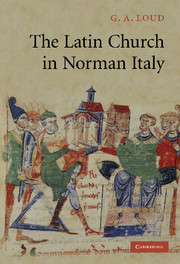Book contents
- Frontmatter
- Contents
- Preface
- List of maps
- List of abbreviations
- Map I Southern Italy: archbishoprics and principal bishoprics
- Map II Southern Italy: abbeys
- Map III The dioceses of Sicily in the late twelfth century
- Map IV The dioceses of the Terra di Bari
- Map V The dioceses of the Terra di Lavoro
- Introduction
- 1 The Church in southern Italy before the Normans
- 2 The Church and the Norman conquest
- 3 The papacy and the rulers of southern Italy
- 4 The papacy and the Church in southern Italy
- 5 The kings of Sicily and the Church
- 6 The Church and military obligation
- 7 The secular Church
- 8 Monasticism
- 9 Latins, Greeks and non-Christians
- Conclusion
- Appendices
- I The dioceses of the kingdom of Sicily in the later twelfth century
- II Incomes of selected bishoprics from mainland southern Italy, according to the papal tax lists of 1308/10
- III Incomes of the bishoprics on the island of Sicily, according to the papal tax lists of 1274/80 and 1308/10
- IV Incomes of the principal monasteries of the kingdom of Sicily, according to the papal tax lists of 1308/10
- V Cistercian abbeys in the kingdom of Sicily, c. 1144–1220
- VI The succession of the archbishops of Capua during the reign of King Roger, 1130–54
- Bibliography
- Index
VI - The succession of the archbishops of Capua during the reign of King Roger, 1130–54
Published online by Cambridge University Press: 04 May 2010
- Frontmatter
- Contents
- Preface
- List of maps
- List of abbreviations
- Map I Southern Italy: archbishoprics and principal bishoprics
- Map II Southern Italy: abbeys
- Map III The dioceses of Sicily in the late twelfth century
- Map IV The dioceses of the Terra di Bari
- Map V The dioceses of the Terra di Lavoro
- Introduction
- 1 The Church in southern Italy before the Normans
- 2 The Church and the Norman conquest
- 3 The papacy and the rulers of southern Italy
- 4 The papacy and the Church in southern Italy
- 5 The kings of Sicily and the Church
- 6 The Church and military obligation
- 7 The secular Church
- 8 Monasticism
- 9 Latins, Greeks and non-Christians
- Conclusion
- Appendices
- I The dioceses of the kingdom of Sicily in the later twelfth century
- II Incomes of selected bishoprics from mainland southern Italy, according to the papal tax lists of 1308/10
- III Incomes of the bishoprics on the island of Sicily, according to the papal tax lists of 1274/80 and 1308/10
- IV Incomes of the principal monasteries of the kingdom of Sicily, according to the papal tax lists of 1308/10
- V Cistercian abbeys in the kingdom of Sicily, c. 1144–1220
- VI The succession of the archbishops of Capua during the reign of King Roger, 1130–54
- Bibliography
- Index
Summary
The succession to this important see during the reign of Roger II had significant repercussions for both royal and papal policy towards the Church, but unfortunately it appears to be both particularly complex, and poorly documented. Insofar as this is possible, this note will attempt to clarify the situation.
Archbishop Hugh (I) is attested in February 1130, consenting to a property exchange involving one of the city churches, and again in November of that year, when Anacletus II revoked an earlier bull making the nunnery of St John the Baptist subject to the archbishop, which he claimed the latter had persuaded him to grant fraudulenter. (This nunnery had in fact long been subject to Montecassino.) Which, therefore, leaves it unclear whether Hugh had recognised Anacletus as pope.
The next reference we have to an incumbent of this see comes in 1135, when Alexander of Telese described how a delegation of the clergy and laity of Capua, with King Roger's advice, elected a cleric called William, ‘a man well endowed with both Divine and secular knowledge’, to the archbishopric, adding that his predecessor had been deposed for simony. A plausible reconstruction of the chronology of Alexander's account suggests that this took place at the very end of August 1135. Alexander did not, however, name this predecessor of William who had been deposed, which leaves it unclear whether this was Hugh (I) or some unknown successor.
- Type
- Chapter
- Information
- The Latin Church in Norman Italy , pp. 534 - 537Publisher: Cambridge University PressPrint publication year: 2007

